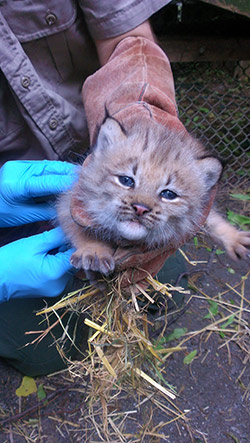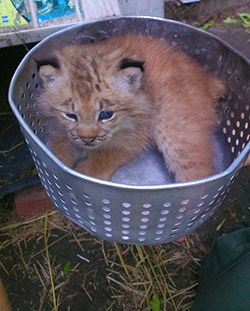Lynx kittens born at Stone Zoo
Monday June 23, 2014
 The staff at Stone Zoo is pleased to announce the birth of Canada lynx kittens, which marks the first successful births of this species at the Zoo.
The staff at Stone Zoo is pleased to announce the birth of Canada lynx kittens, which marks the first successful births of this species at the Zoo.
On May 19, Patty, the female lynx at Stone Zoo, gave birth to four kittens. Unfortunately, one of the kittens died within 24 hours. The remaining three kittens are doing well and are becoming quite curious about their surroundings.
On June 19, the kittens, a male and two females, had their first medical exam where they were weighed and their overall health was assessed. The male weighs 2 pounds 3 ounces, while the females each weigh 1 pound 12 ounces.
“The three kittens appear healthy, bright and alert,” said Dr. Susan Bartlett, Zoo New England Associate Veterinarian. “As with any new birth, we are carefully monitoring the mother and kittens. The mother is very protective of her kittens and is doing everything a lynx mother should.”
Zoo New England participates in the Canada Lynx Species Survival Plan (SSP), which is a cooperative, inter-zoo program coordinated nationally through the Association of Zoos and Aquariums (AZA). SSPs are designed to maintain genetically diverse and demographically stable captive populations of species. The births are the result of a recommended breeding between Patty and her mate Hutch.
Since their birth, the kittens have been in the nest box with their mother. They are expected to make their public debut in a few weeks at their exhibit in the Yukon Creek section of the Zoo.
 “We are extremely excited about these births and are looking forward to when they make their exhibit debut,” said Pete Costello, Assistant Curator of Stone Zoo, who added, “Patty is a very protective mother and she even covers up the kittens with straw when she leaves the nest box. The kittens have been nursing well and they are starting to become very interested in their environment.”
“We are extremely excited about these births and are looking forward to when they make their exhibit debut,” said Pete Costello, Assistant Curator of Stone Zoo, who added, “Patty is a very protective mother and she even covers up the kittens with straw when she leaves the nest box. The kittens have been nursing well and they are starting to become very interested in their environment.”
In the wild, Canada lynx can be found in Alaska and Canada. They have been reported in the northern plains and Great Lakes states as well as in states including Wyoming, Oregon, Utah, Colorado and Maine. While they primarily live in dense forests, they may also be found in rocky areas and the tundra, primarily in Canada. Their numbers substantially decrease in the more populous southeastern region.
Well-equipped for snow, Canada lynx have large, thickly furred paws that act as snow shoes, allowing them to easily walk in deep snow. Lynx have long, thick yellowish brown fur that may be patterned with dark spots. This tall cat has especially long hind legs, which give it the appearance of being titled forward. Their ears are tipped with black tufts of hair and there is usually a flaring ruff of fur around their necks. Solitary and nocturnal, lynx use their keen eyesight to stalk prey. While they can climb trees, they prefer to stay on the ground.
Stone Zoo has exhibited Canada lynx since 2000.
________________________________________________________________________________
Zoo New England manages Franklin Park Zoo in Boston and Stone Zoo in Stoneham. Both are accredited by the Association of Zoos and Aquariums (AZA). Zoo New England's mission is to inspire people to protect and sustain the natural world for future generations by creating fun and engaging experiences that integrate wildlife and conservation programs, research, and education.

